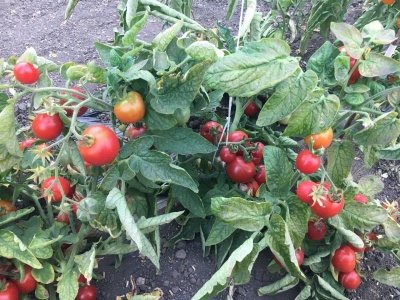
- Authors: Selection of the Suydinsky branch of the North-West Research Institute of Agriculture
- Category: grade
- Growth type: determinant
- Appointment: fresh consumption
- Ripening period: early
- Ripening time, days: 90-105
- Growing conditions: for open ground, for film greenhouses
- Bush height, cm: 25-30
- Foliage: weak
- Ripe fruit color: Orange
New varieties of tomatoes are constantly appearing. But this does not mean that one should strive to choose the freshest varieties. On the contrary, a careful acquaintance with the features of the Nevsky Prospect makes it possible to obtain a very attractive result.
Description of the variety
It is known that this culture was created in the Suidinsky branch of the north-western research institute of agriculture. However, the specific year of the adoption of the development in the State Register has not been announced. Nevsky is a typical determinant tomato. It can be grown both outdoors and in greenhouses under film shelters. The height of the bushes does not exceed 25-30 cm, the number of leaves is small, but the formation of boles is noted.
The main qualities of the fruit
Ripe berries of Nevsky tomato are orange in color. Their mass ranges from 40 to 60 g. In shape, the tomato resembles a flat circle. One cluster can contain from 4 to 6 fruits.
Taste characteristics
The fruits of Nevsky are pleasantly sweet. The share of dry matter is not more than 5%. Crop reviews are almost always excellent.
Ripening and fruiting
Nevsky is one of the earliest tomatoes. On average, for the normal development of its harvest, it takes 90-105 days. As always, the countdown is carried out from the appearance of the first green growth to the formation of fully ripe berries. Mostly they begin to harvest in the first decade of July. The collection can continue until mid-August.
Yield
1 plant can form 1.5 kg of berries. Fee from 1 sq. m of the garden reaches 7-8 kg of fruit. This is a very worthy result, especially since it is achieved stably, you just need to maintain normal agricultural technology.
The timing of planting seedlings and planting in the ground
Usually, seeds are placed in seedling containers at the end of March. But it is not too late to do this in early April. With the normal dynamics of the development of seedlings, the time to transfer them into open ground comes in late May or early June. True, here it is already necessary to take into account the degree of maturity of specific plants. And you will also need to make sure that the soil has really warmed up.

Growing tomato seedlings is an extremely important process, because it largely depends on whether the gardener can harvest at all. All aspects must be taken into account, from seedbed preparation to planting in the ground.
Landing scheme
For 1 sq. m there can be no more than 5 plants of this variety. If the plantings are too thick, problems inevitably arise. Planting holes should be approximately 20 cm deep. The recommended gap between these holes is 30-40 cm.

Growing and care
There is no need to clean up stepchildren under normal conditions (if the culture is not running). With such a small stature, which is typical for Nevsky, there is no question of a garter to the support either. But the formation of plants will be required. It is recommended to lead the bushes in 3-4 stems. The advantage is almost zero danger of late blight and high resistance to cold - but it is hardly worth abusing these possibilities.
In the first week of development of seedlings, a temperature of + 13 ... 15 degrees should be maintained. Then it is gradually increased to +23 degrees. Such sprouts are watered weekly. If suddenly hot weather comes, they need to be watered even more often. A pick into separate containers is made when the plants get stronger and the real leaves are thrown out.
Immediately after the pick, fertilizing with nitrogen fertilizers is carried out. In the last 10 days, seedlings must be hardened before transplanting into open ground. Typically, hardening is carried out for about 2 hours every day. In this case, it is necessary to carefully monitor that the air temperature does not fall below +10 degrees. Approximately 48 hours before transplanting to a permanent seat, add there:
a small amount of peat;
humus;
sand.
Other planting care measures are quite simple. During rapid growth, potash-phosphorus fertilizers are used. It is necessary to irrigate the bushes 1 or 2 times a week, focusing on the weather conditions. There should be no weeds near the tomatoes. Spraying to protect against pests is carried out only as needed.




A plant needs different micronutrients at each stage of growth. All fertilizers can be divided into two groups: mineral and organic. Folk remedies are often used: iodine, yeast, bird droppings, eggshells.
It is important to observe the rate and period of feeding. This also applies to folk remedies and organic fertilizers.


Review overview
The Nevsky tomato is highly valued by gardeners. It is noted that in almost any weather it will confidently supply gardeners with a high quality crop.The bushes will have excellent neatness. Even when grown for 10-15 years, no complaints about the culture arise.

























































































